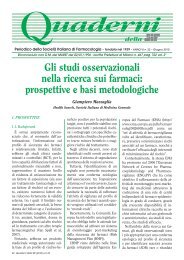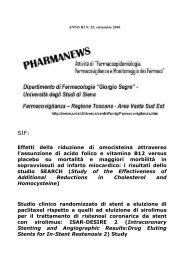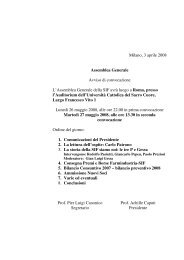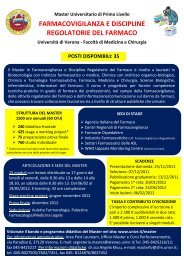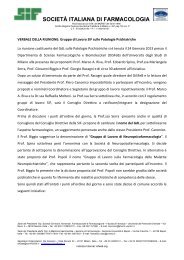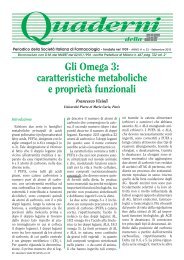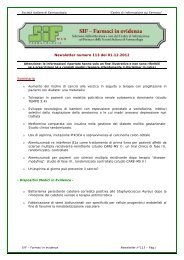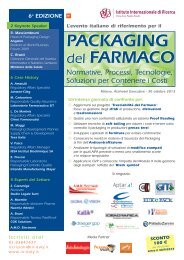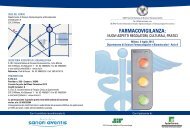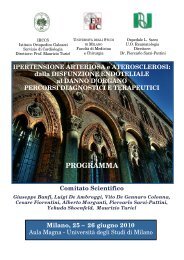scienze della vita roma, 22-23 ottobre 2012 - SIF
scienze della vita roma, 22-23 ottobre 2012 - SIF
scienze della vita roma, 22-23 ottobre 2012 - SIF
Create successful ePaper yourself
Turn your PDF publications into a flip-book with our unique Google optimized e-Paper software.
SERIAL GENE EXPRESSION ANALYSIS IN PERIPHERAL BLOOD<br />
MONONUCLEAR CELLS OF PATIENTS WITH IDIOPATHIC AND<br />
HERITABLE PULMONARY ARTERIAL HYPERTENSION<br />
S. Cantoni 1,2 , M. Galletti 1,2 , R. Tassinari 1,2 , A. Guffanti 3 , E. Brini 3 , F. Zambelli 1 , C. Ventura 1,2 , N.<br />
Galiè 2<br />
1 National Institute Biostructures and Biomolecules, Bologna Italy; 2 Cardiovascular Department<br />
University of Bologna, Bologna Italy; 3 Genomnia s.r.l.- Milano, Italy.<br />
Introduction<br />
Pulmonary arterial hypertension (PAH) is a rare disorder characterized by progressive increase in<br />
pulmonary vascular resistance, right ventricular failure and premature death. PAH can be idiopathic<br />
(IPAH), heritable (HPAH), or associated with other conditions, such as scleroderma or congenital<br />
heart disease.<br />
Studying pulmonary vascular diseases, such as PAH, access to affected tissue is especially<br />
problematic for investigators. Due to high risk for complication, lung biopsies are not routinely<br />
performed, prompting for alternative cell sources and molecular approaches. In this contest the<br />
prominent role of inflammation in the development of PAH lead to consider peripheral blood<br />
mononuclear cells (PBMCs) as a valuable tool for investigating pathologic processes, representing a<br />
convenient source for the assessment of alteration in gene associated with immune-related diseases.<br />
So far, only a few transcriptional studies for PAH have been performed with PBMCs using<br />
microarray analysis. Compared to this technique, Serial Analysis of Gene Expression (SAGE) has<br />
remarkable advantages. Since it does not require prior knowledge of the sequences to be analyzed,<br />
SAGE can be used to obtain complete transcriptional profiles of expressed genes, albeit unknown<br />
genes.<br />
Methods<br />
SAGE allows quantitative analysis of thousands transcripts, relying on the principle that a short<br />
oligonucleotide sequence (tag) can uniquely identify mRNA transcripts. Tag frequency in SAGE<br />
library reflects transcript abundance. For the study we enrolled 15 PAH patients (5 IPAH nonresponder,<br />
5 IPAH responder, 5 HPAH), 4 healthy BMPR2 mutation carriers and 6 healthy subjects<br />
(HS). Patients were diagnosed according to the 2009 ESC/ERS guidelines and blood samples were<br />
collected before PAH therapy initiation.<br />
Results<br />
Starting from 6 million of tags, corresponding to 15,000 transcripts, comparative analysis of<br />
different groups revealed that significant differential expression was only restricted to a hundred of<br />
down- or up-regulated genes. Interestingly, computational analysis revealed that genes can be<br />
clustered into functional networks, sharing a number of crucial features in cellular homeostasis and<br />
signaling (migration, proliferation, inflammation). Overlapping analysis revealed genes shared<br />
between IPAH responder/ non-responder patients, and between HPAH patients/ healthy mutated<br />
carriers.<br />
Conclusions<br />
SAGE can provide affordable analysis of genes amenable for molecular dissection of PAH using<br />
PBMCs as a<br />
sentinel, surrogate tissue.<br />
56



